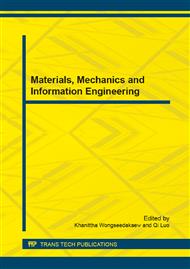[1]
YANG Xiaoliang, LIU Wei, WU Tianzuo, et al. Coupling mechanism analysis of a slender delta wing in combined free-roll and free-sideslip motion [J]. Acta Aerodynamica Sinica, 2014, 32 (1): 1-7. (in China).
Google Scholar
[2]
Boyd T. ONE HUNDRED YEARS OF GH BRYAN'S STABILITY IN AVIATION [J]. Journal of Aeronautical History Paper No, 2011, 4.
Google Scholar
[3]
NIELSEN J. Missile aerodynamics [J]. (1988).
Google Scholar
[4]
Thbodohsbn T. General theory of aerodynamic instability and the mechanism of flutter [J]. (1935).
Google Scholar
[5]
Albano E, Rodden WP. A doublet-lattice method for calculating lift distributions on oscillating surfaces in subsonic flows [J]. AIAA journal, 1969, 7 (2): 279-85.
DOI: 10.2514/3.5086
Google Scholar
[6]
Yang Yongnian, Zhao Lingcheng. Unsteady aerodynamic and flutter [M]. Xi'An: Northwestern polytechnical university press. 1982. (in China).
Google Scholar
[7]
Robinson BA, Yang HT, Batina JT. Aeroelastic analysis of wings using the Euler equations with a deforming mesh [J]. Journal of Aircraft, 1991, 28 (11): 781-8.
DOI: 10.2514/3.46096
Google Scholar
[8]
Melville RB, Morton SA, Rizzetta DP. Implementation of a fully-implicit, aeroelastic Navier-Stokes solver [J]. AIAA Paper-97-2039, (1997).
DOI: 10.2514/6.1997-2039
Google Scholar
[9]
Zhang Xijin. Plane Design Manual: aerodynamic design [M]. Aviation Industry Press, 2002. (in China).
Google Scholar
[10]
Xiong Haiquan, Liu Chao, Zheng Benwu. Aircraft flight dynamics [M]. BeiJing: Aviation industry press, 1990. (in China).
Google Scholar
[11]
Hu Zhaofeng. Flight dynamics: Stability and maneuverability of plane [M]. National Defence Industry Press, 1985. (in China).
Google Scholar
[12]
Roskam J. Airplane design part VI: preliminary calculation of aerodynamic, thrust and power characteristics [J]. Roskam Aviation and Engineering Corporation, Kansas, (1990).
Google Scholar
[13]
Hemsch MJ, Hong Jinsen, Yang Qide. Tactical missile aerodynamics [M]. BeiJing: Aerospace press. (1999).
Google Scholar
[14]
TONG BG, Hui W. Unsteady embedded Newton-Busemann flow theory [J]. Journal of Spacecraft and Rockets, 1986, 23 129-35.
DOI: 10.2514/3.25798
Google Scholar
[15]
Vukelich S, Williams J: AFFDL-TR-79-3032. April, (1979).
Google Scholar
[16]
Roskam J. Airplane design [M]. DARcorporation, (1985).
Google Scholar
[17]
Schummer J. A Conceptual Approach [J]. HYLE-International Journal for Philosophy of Chemistry, 1998, 4 (2): 129-62.
Google Scholar
[18]
East RA, Hutt GR. Comparison of predictions and experimental data for hypersonic pitching motion stability [J]. Journal of Spacecraft and Rockets, 1988, 25 (3): 225-33.
DOI: 10.2514/3.25975
Google Scholar
[19]
Clark WS, Hall KC. A time-linearized Navier-Stokes analysis of stall flutter [J]. Journal of Turbomachinery, 2000, 122 (3): 467-76.
DOI: 10.1115/1.1303073
Google Scholar
[20]
Van Der Weide E, Gopinath A, Jameson A. Turbomachinery applications with the time spectral method [J]. AIAA Paper, 2005, 4905 (2005).
DOI: 10.2514/6.2005-4905
Google Scholar
[21]
Dufour G, Sicot F, Puigt G, et al. Contrasting the harmonic balance and linearized methods for oscillating-flap simulations [J]. AIAA journal, 2010, 48 (4): 788-97.
DOI: 10.2514/1.43401
Google Scholar
[22]
Blanc F, Roux F-X, Jouhaud J-C. Harmonic-Balance-Based Code-Coupling Algorithm for Aeroelastic Systems Subjected to Forced Excitation [J]. AIAA journal, 2010, 48 (11): 2472-81.
DOI: 10.2514/1.45444
Google Scholar
[23]
Pechloff AN, Laschka B. Small disturbance Navier-Stokes method: Efficient tool for predicting unsteady air loads [J]. Journal of aircraft, 2006, 43 (1): 17-29.
DOI: 10.2514/1.14350
Google Scholar
[24]
Hall KC, Thomas JP, Clark WS. Computation of unsteady nonlinear flows in cascades using a harmonic balance technique [J]. AIAA journal, 2002, 40 (5): 879-86.
DOI: 10.2514/3.15137
Google Scholar
[25]
Thomas JP, Dowell EH, Hall KC. Nonlinear inviscid aerodynamic effects on transonic divergence, flutter, and limit-cycle oscillations [J]. AIAA journal, 2002, 40 (4): 638-46.
DOI: 10.2514/3.15109
Google Scholar
[26]
Da Ronch A. On the calculation of dynamic derivatives using computational fluid dynamics [D]; University of Liverpool, (2012).
Google Scholar


